Getting started with Raspberry Pi: Raspberry Pi 3 Model B
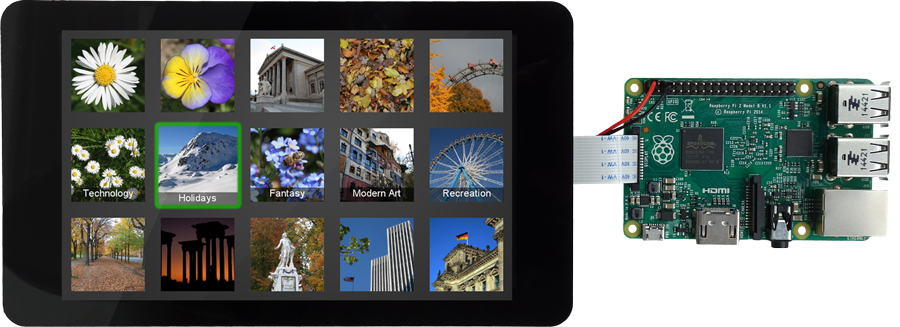
Raspberry Pi 3 Model B with 7" touch screen.
The following article explains all necessary steps to create an Embedded Wizard UI application suitable for the Raspberry Pi 3 Model B with Raspberry Pi 7" Touch Display. This getting started article is also applicable for Raspberry Pi 2 Model B.
Please follow these instructions carefully and step by step in order to ensure that you will get everything up and running on your target. In case you are not familiar with Embedded Wizard, please read first the chapter basic concepts and the Quick Tour tutorial to understand the principles of Embedded Wizard and the GUI development workflow.
Prerequisites
First, make sure you have all of the following items:
Hardware components
★Suitable power supply for your Raspberry Pi board and display
★Network cable to connect the Raspberry Pi board with your network
★Micro SD card with 8GB
Software components
★Embedded Wizard Studio Free or Embedded Wizard Studio Pro
If you want to use the Free edition of Embedded Wizard Studio please register on our website and download the software.
As a customer, please visit the Embedded Wizard Download Center (login/password required) and download Embedded Wizard Studio Pro.
★Embedded Wizard Build Environment for Raspberry Pi 3B
To evaluate Embedded Wizard on the mentioned target, you can download the suitable Build Environment from the following link:
![]() RasPi-3B-BuildEnvironment-V13.03.00.00.zip
RasPi-3B-BuildEnvironment-V13.03.00.00.zip
As a customer, please visit the Embedded Wizard Download Center (login/password required) and download the latest version of the Build Environment and your licensed Platform Package libraries or source codes.
Installing Tools and Software
★Step 1: Install the latest version of Embedded Wizard Studio.
★Step 2: Unpack the provided Embedded Wizard Build Environment for Raspberry Pi into a new directory, e.g. {UserDocumentFolder}\RasPi-3B.
★Step 3: Write the Raspberry Pi OS Lite (Legacy) Buster image to your SD card (please have a look to the Raspberry Pi installation guide for more details).
IMPORTANT
Please make sure to use the Raspberry Pi OS Lite Buster! The newer Raspberry Pi OS Bullseye does no more contain the Broadcom OpenGL drivers.
Exploring the Build Environment
The provided Embedded Wizard Build Environment for Raspberry Pi contains everything you need to create, compile and link an Embedded Wizard UI application for the Raspberry Pi target. After unpacking, you will find the following subdirectories and files:
•\Application - This folder contains a ready-to-use project to compile and link an Embedded Wizard generated UI application. It is used for all provided examples and it can be used to build your own UI applications.
•\GeneratedCode - This folder is used to receive the generated code from an Embedded Wizard UI project. The template project is building the UI application out of this folder. You can create your own UI project and generate the code into the subdirectory \GeneratedCode without the need to adapt the project.
•\Project - This folder contains the prepared project for GCC (make).
•\Source - This folder contains the files main.c and ewmain.c. There you will find the initialization of the system and the main loop to drive an Embedded Wizard GUI application. The file ewconfig.h contains general configuration settings for the target system, like memory ranges and display parameter and configuration settings for the Embedded Wizard Graphics Engine and Runtime Environment. Additionally, this folder contains the device driver C/H files used for the DeviceIntegration example.
•\Examples\<ScreenSize> - This folder contains a set of demo applications prepared for a dedicated screen size (800x480 pixel). Each example is stored in a separate folder containing the entire Embedded Wizard UI project. Every project contains the necessary profile settings for the Raspberry Pi target. The following samples are provided:
•\HelloWorld - A very simple project that is useful as starting point and to verify that the entire toolchain, your installation and your board is properly working.
•\ScreenOrientation - This demo provides a simple GUI in portrait and landscape orientation. This demo is helpful to play with the orientation of the display and to check the touch coordinates.
•\DeviceIntegration - This example shows the integration of devices into a UI application and addresses typical questions: How to start a certain action on the target? How to get data from a device?
•\GraphicsAccelerator - This application demonstrates the graphics performance of the target by using sets of basic drawing operations that are executed permanently and continuously.
•\BezierClock - The sample application BezierClock implements a fancy digital clock and timer application with animated digits. The application uses vector graphics to render dynamically the different digits for clock and timer. The change from one digit to another is handled by moving the vector points to get a smooth transition animation.
•\BrickGame - The sample application BrickGame implements a classic "paddle and ball" game. In the game, a couple of brick rows are arranged in the upper part of the screen. A ball travels across the screen, bouncing off the top and side walls of the screen. When a brick is hit, the ball bounces away and the brick is destroyed. The player has a movable paddle to bounce the ball upward, keeping it in play.
•\ChartsDemo - This application demonstrates the possibilities and the usage of the chart classes LineChart, BarChart and PieChart. The appearance of each chart diagram can be configured easily by using their corresponding properties. Additionally, this demo shows the usage of an outline box to manage scrollable content.
•\ClimateCabinet - The ClimateCabinet demo shows the implementation of a control panel for a climatic exposure test cabinet. The user can define a heating time, a nominal temperature and humidity, a dwell time and the final cooling time.
•\Dashboard - The sample application Dashboard shows the implementation of a car dashboard. The application demonstrates the usage of vector graphics created from svg path data and how transitions between two dashboard variants and further UI components can be achieved.
•\PaperCutter - This demo shows the implementation of a paper cutting machine, where the user can define the pagination and format of the paper as well as the cutting speed and the amount of papers. The application contains many rect effects and fade-in/fade-out effects to change dynamically the layout of the screen.
•\PatientMonitor - This application displays continuously measured data in an overwriting data recorder (such as an oscilloscope). The data graphs of the (simulated) measured values and the dialogs for user settings are presented in a modern, clean medical style. Dialogs are using blur filters to show the content behind them with a glass effect.
•\PulseOximeter - The sample application PulseOximeter shows the implementation of a medical device for monitoring a person's pulse frequency and peripheral oxygen saturation. The application demonstrates the usage of vector graphics within graphs and circular gauges.
•\ScreenOrientation - This demo shows, that the orientation of the UI application is independent from the physical orientation of the display.
•\SmartThermostat - The SmartThermostat demo application shows the implementation of a fancy, rotatable temperature controller to adjust and display the nominal and actual temperature.
•\WashingMachine - This demo shows the implementation of a washing machine with a couple of fancy scrollable list widgets to choose the washing program and parameters. The speciality of this sample application is the magnification effect of the centered list items and the soft fade-in/fade-out effects.
•\WaveformGenerator - This WaveformGenerator demo application combines waveforms with different amplitudes and frequencies. The implementation shows the usage of vector graphics to draw a curve based on a list of coordinates.
•\MasterDemo - This folder contains the binary file of the Embedded Wizard Master Demo. It combines a variety of examples within one huge demo application. It can be used for presentations and showcases.
•\PlatformPackage - This folder contains the necessary source codes and/or libraries of the Linux OpenGL Platform Package: The Graphics Engine (in the subdirectory \RGBA8888) and the Runtime Environment (in the subdirectory \RTE).
•\TargetSpecific - This folder contains all configuration files and platform specific source codes. The different ew_bsp_xxx files implement the bridge between the Embedded Wizard UI application and the underlying Raspberry Pi hardware drivers in order to access the display (via EGL), the serial interface and the touch driver.
Preparing the PC
★Share your new Build Environment folder {UserDocumentFolder}\RasPi-3B as RasPi-3B and allow read/write access for everybody.
★Get the IP address of your PC - for example by using the command ipconfig within the Windows command line and note it (e.g. 192.168.0.xxx).
Preparing the Raspberry Pi
★Connect the display with the Raspberry Pi board.
★Connect a standard USB keyboard at the Raspberry Pi board.
★Connect the Raspberry Pi board to your network router.
★Insert the SD card and power on the system.
★Login as pi with password raspberry. Please take care if you are using a keyboard with a non-QWERTY layout.
★Update your Raspberry Pi system to the latest software version:
sudo apt-get update sudo apt-get full-upgrade
★Start the Raspberry Pi configuration tool (via sudo raspi-config) and enable SSH (submenu of 'Interfacing Options').
★Shutdown the board via sudo halt and power off.
★Disconnect the USB keyboard and power on the system.
★When the boot procedure of the Raspberry Pi is completed you can read the IP address of the Raspberry Pi on the display: e.g. My IP address is 192.168.0.yyy.
Mounting the Project Directory
★Open a SSH client (e.g. 'Putty') on your PC and connect to the Raspberry Pi by using the IP address of the Raspberry Pi (e.g. 192.168.0.yyy).
★Login as pi with password raspberry.
★Create a new directory share on your Raspberry Pi:
mkdir share
★Mount the Build Environment folder of your PC to this new share directory. Please use the IP address of your PC and your login name on the PC. In order to get access to your shared directory, you need to insert your PC login password.
sudo mount.cifs //192.168.178.xxx/RasPi-3B /home/pi/share/ -o user=<YourWindowsLogin>
★Change into the new directory share on your Raspberry Pi and check if you see the content of the mounted PC folder.
cd share ls
As a result you should see the content of the Raspberry Pi Build Environment.
Creating the UI Examples
For the first bring up of your system, we recommend to use the example 'HelloWorld':

Example 'HelloWorld' within Embedded Wizard Studio.
The following steps are necessary to generate the source code of this sample application:
★On your PC, navigate to the directory \Examples\<ScreenSize>\HelloWorld.
★Open the project file HelloWorld.ewp with your previously installed Embedded Wizard Studio. The entire project is well documented inline. You can run the UI application within the Prototyper by pressing Ctrl+F5.
★To start the code generator, select the menu items - or simply press F8. Embedded Wizard Studio generates now the sources files of the example project into the directory \Application\GeneratedCode.
Compiling, Linking and Executing
The following steps are necessary to build and execute the Embedded Wizard UI sample application on the Raspberry Pi. Please note, that the entire project is build directly on your Raspberry Pi target, without using a cross compiler.
★The SSH client should be still opened (otherwise connect again and mount the shared folder).
★Change to administrator rights on your Raspberry Pi:
sudo -s
★Navigate to the subdirectory \Application\Project and make the binary:
cd /home/pi/share/Application/Project make
★Finally, the application can be executed on the Raspberry Pi:
./EmbeddedWizard-RasPi-3B
This is the resulting application on your Raspberry Pi target:
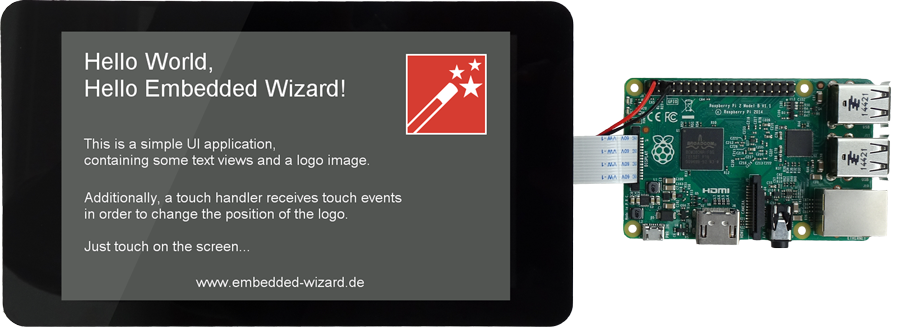
Example 'HelloWorld' running on Raspberry Pi board.
The application can be terminated by pressing P.
All other examples can be created in the same way: Just open the desired example with Embedded Wizard Studio, generate code and rebuild the whole application.
Creating your own UI Applications
In order to create your own UI project suitable for the Raspberry Pi target, you can create a new project and select the Raspberry Pi OpenGL project template:
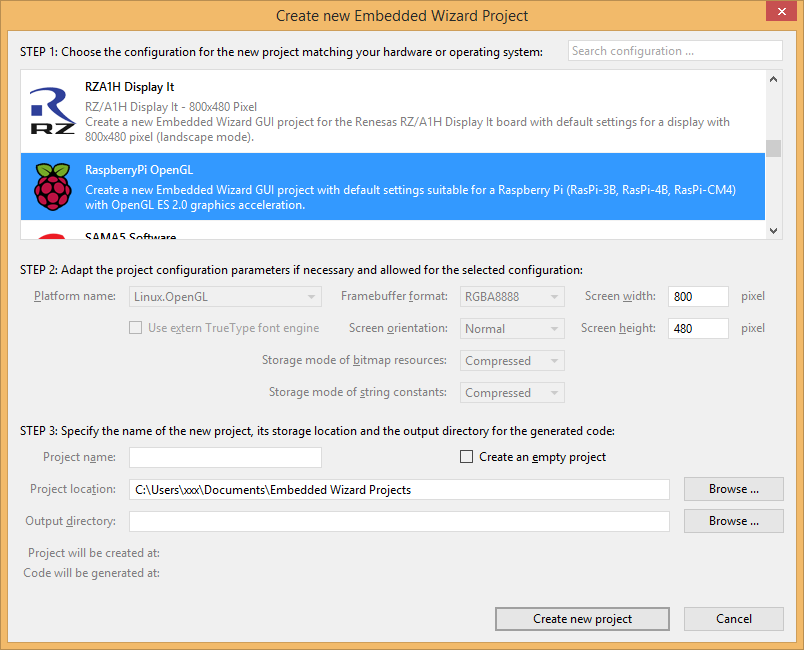
As a result you get a new Embedded Wizard project, that contains the necessary Profile attributes suitable for the Raspberry Pi board:
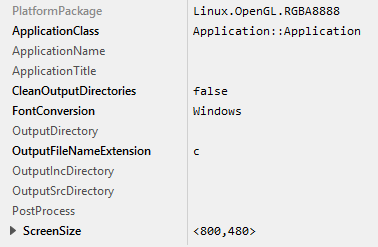
The following profile settings are important for your target:
★The attribute PlatformPackage should refer to the Linux OpenGL Platform Package.
★The attribute ScreenSize should correspond to the display size of the Raspberry Pi touch screen.
★The attribute OutputDirectory should refer to the \Application\GeneratedCode directory within your Build Environment. By using this template, it will be very easy to build the UI project for your target.
Now you can use the template project in the same manner as it was used for the provided examples to compile and link the binary.
After generating code, just build and execute your GUI application in the same way as described above.
Project settings related to the GUI application are taken directly out of the generated code - all other settings can be made directly within the file ewconfig.h, which contains general configuration settings for the target system.
Console output
The SSH client is very helpful to receive error messages or to display simple debug or trace messages from your Embedded Wizard UI application.
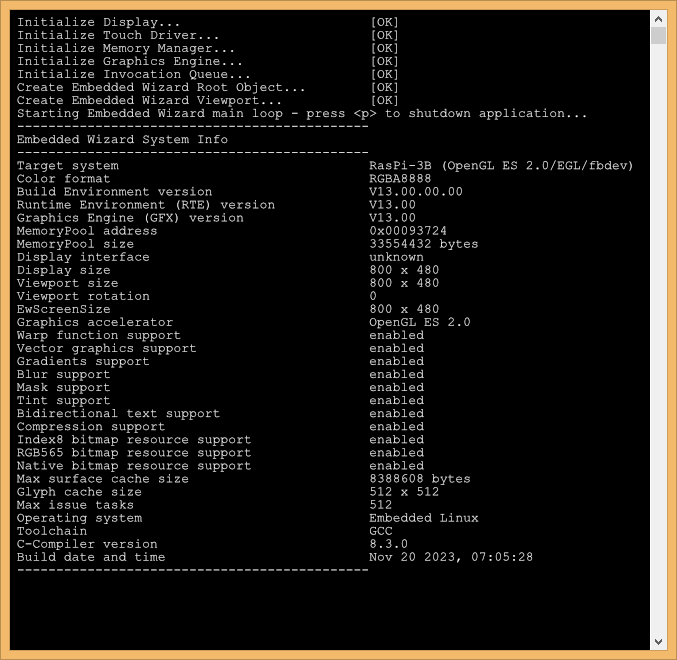
It can be used for all trace statements from your Embedded Wizard UI applications or for all debug messages from your C code.
Accessing Hardware GPIOs
The example DeviceIntegration shows the principles concerning integration of devices into a UI application. In order to access the GPIOs of the Raspberry Pi hardware, the third-party library pigpio is needed. Please download and install the pigpio library first before trying to build the binary of the example.
In this sample application the following interactions are shown:
★Transmitting a string
★Switching a LED on/off
★Receiving an event and a counter value when a hardware button is pressed
Since the Raspberry Pi hardware does not provide LEDs or buttons, please make the following connections:
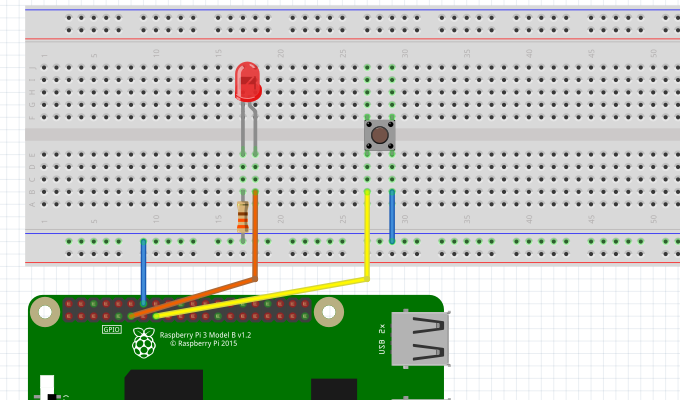
The LED is connected to GPIO 17 - the button is connected to GPIO 22.
Embedded Wizard GUI Demos
If you just want to run our GUI demos on your Raspberry Pi without building the different examples, you can simply start the binary file of the Embedded Wizard Master Demo.
The Embedded Wizard Master Demo combines a variety of examples within one huge demo application. It can be used for presentations and showcases. Each demo application can be activated from a common main menu. To return back from a demo application to the main menu, a small home button appears on top of every demo. Additionally, the Master Demo contains an auto-demo mode that presents one demo application after the other. The auto-demo starts automatically and stops as soon as the user touches the screen.
In order to start the binary file to your target, please follow these steps:
★The SSH client should be still opened (otherwise connect again and mount the shared folder).
★If not done, change to administrator rights on your Raspberry Pi:
sudo -s
★Navigate to the subdirectory \MasterDemo:
cd /home/pi/share/MasterDemo
★Finally, the application can be executed on the Raspberry Pi:
./EmbeddedWizard-RasPi-3B
This is the resulting application on your Raspberry Pi target:
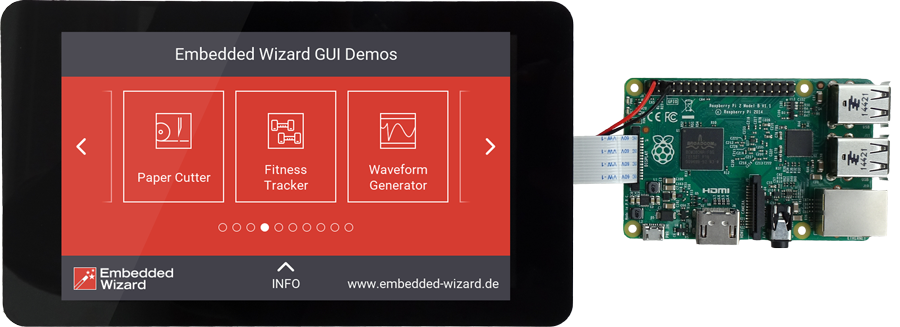
'Master Demo' running on Raspberry Pi.
Release notes
The following section contains the version history of the Build Environment (including Graphics Engine and Runtime Environment) for Raspberry Pi 3B. These release notes describe only the platform specific aspects - for all general improvements and enhancements please see the Embedded Wizard release notes.
Version 13.00.00.00
★The set of examples has been expanded with Patient Monitor Demo.
★Using Graphics Engine (GFX) and Runtime Environment (RTE) V13.00.
★Using Raspberry Pi OS Lite (Legacy) Buster 2023-05-03.
Version 13.01.00.00
★Using Graphics Engine (GFX) and Runtime Environment (RTE) V13.01.
★Bug-fix: Screen update could fail when the frame buffer was configured with EW_PERFORM_FULL_SCREEN_UPDATE to 1. This resulted in black screen.
Version 13.03.00.00
★Using Graphics Engine (GFX) and Runtime Environment (RTE) V13.03.
★Bug-fix: Crash occurred during Garbage Collection when 64-bit data members are used. For more details concerning the fixed error see Known issues. Please don't forget to update your Build Environment and Platform Package modules!
